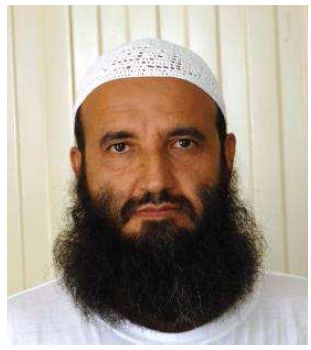Salah Abdul Rasool Al Blooshi is a Bahraini, who was held in extrajudicial detention in the United States Guantanamo Bay detainment camps, in Cuba.
Abdul Aziz Adbullah Ali Al Suadi is a Yemeni citizen who was held in extrajudicial detention in the United States Guantánamo Bay detainment camps, in Cuba, from May 3, 2002, to January 21, 2016. His Guantanamo Internment Serial Number is 578. The Department of Defense reports that Al Suadi was born on June 16, 1974, in Milhan, Yemen.
Abdullah Mujahid is a citizen of Afghanistan who is still held in extrajudicial detention after being transferred from United States Guantanamo Bay detainment camps, in Cuba — to an Afghan prison. His Guantanamo Internment Serial Number was 1100.
Hajji Nasrat Khan is an elderly citizen of Afghanistan best known for the more than three years he spent in extrajudicial detention in the United States Guantanamo Bay detention camps, in Cuba. The United States Department of Defense believed that he was an enemy combatant and assigned him the Internment Serial Number 1009.

Awal Gul was a citizen of Afghanistan who died in extrajudicial detention in the United States Guantanamo Bay detention camps in Cuba after nine years of imprisonment without charge.

Abdul Haq Wasiq is the Director of Intelligence of the Islamic Emirate of Afghanistan since September 7, 2021. He was previously the Deputy Minister of Intelligence in the former Taliban government (1996–2001). He was held in extrajudicial detention in the Guantanamo Bay detainment camps, in Cuba, from 2002 to 2014. His Guantanamo Internment Serial Number was 4. American intelligence analysts estimate that he was born in 1971 in Ghazni Province, Afghanistan.
Hammdidullah, a.k.a.Janat Gul, is a citizen of Afghanistan who was held in extrajudicial detention in the United States Guantanamo Bay detainment camp, in Cuba. American counter-terror analysts estimate he was born in 1973, in Sarpolad, Afghanistan.
Shawali Khan is a citizen of Afghanistan, who was held in extrajudicial detention in the United States Guantanamo Bay detainment camps, in Cuba. His Guantanamo Internment Serial Number was 899. American intelligence analysts estimate he was born in 1963, in Kandahar, Afghanistan.
Abdul Baseer Nazim is a citizen of Afghanistan who is still held in extrajudicial detention after being transferred from United States Guantanamo Bay detainment camps, in Cuba — to an Afghan prison.

Mullah Abdul Rauf Aliza, widely identified as Mullah Abdul Rauf Khadim, was an Afghan militant who served as a senior leader in both the Taliban and ISIS-K.
Ali Abdul Motalib Awayd Hassan Al Tayeea is a citizen of Iraq who was held in extrajudicial detention in the United States's Guantanamo Bay detention camps, in Cuba. His Guantanamo Internment Serial Number was 111. The Department of Defense reports that Al Tayeea was born in Baghdad, Iraq. The Department of Defense provided a birthday, or an estimated year of birth, for all but 22 of the 759 detainees. Al Tayeea is one of those 22. He was repatriated on January 17, 2009, after more than seven years without ever been charged.

Mohammed Fenaitel Mohamed Al Daihani is a citizen of Kuwait who was held in extrajudicial detention in the United States Guantanamo Bay detention camp, in Cuba. Al Daihani's Guantanamo Internment Serial Number was 229. Joint Task Force Guantanamo counter-terrorism analysts reports that Al Daihani was born on November 4, 1965, in Kuwait City, Kuwait. Al Dehani was repatriated without charges on November 2, 2005.
Faris Muslim al Ansari is a citizen of Afghanistan who was seventeen years old when captured and held in the United States's Guantanamo Bay detention camps, in Cuba. His Guantanamo Internment Serial Number was 253. American intelligence analysts estimate that Al Ansari was born in 1984 in Mukala, Yemen.
Jawad Jabber Sadkhan is a citizen of Iraq who was held in extrajudicial detention in the United States Guantanamo Bay detainment camps, in Cuba. Sadkhan's Guantanamo Internment Serial Number was 433.
Abib Sarajuddin is a citizen of Afghanistan, who was held in extrajudicial detention in the United States Guantanamo Bay detention camps, in Cuba. His Guantanamo Internment Serial Number was 458. Guantanamo intelligence analysts estimate that he was born in 1942.
Abdul Majid Muhammed is a citizen of Iran who was held in extrajudicial detention in the United States Guantanamo Bay detention camp in Cuba.
Hajji Sahib Rohullah Wakil is a citizen of Afghanistan who was held in extrajudicial detention in the United States Guantanamo Bay detention camps, in Cuba. His Guantanamo Internment Serial Number was 798. American intelligence analysts estimate he was born in 1962, in Jalalabad, Afghanistan. He has since been transferred from Guantanamo Bay to the American wing of the Pol-e-Charkhi prison in Kabul, Afghanistan. On November 18, 2019, the U.S. Department of the Treasury designated him for supporting activities of the ISIS branch in Afghanistan.

Sabar Lal Melma was a citizen of Afghanistan who was held in extrajudicial detention in the United States Guantanamo Bay detainment camps, in Cuba. Sabar Lal Melma's Guantanamo Internment Serial Number was 801. American intelligence analysts estimate that Sabar Lal Melma was born in 1962, at Darya-e-Pech, Afghanistan.
Turki Mash Awi Zayid Al Asiri was a citizen of Saudi Arabia who was held in extrajudicial detention in the United States's Guantanamo Bay detention camps, in Cuba. His Guantanamo Internment Serial Number was 185. Joint Task Force Guantanamo counter-terrorism analysts reports that Al Asiri was born on March 8, 1975, in Yaboq, Saudi Arabia.

Mullah Noorullah Noori is a militant and Minister of Borders and Tribal Affairs of the Islamic Emirate of Afghanistan since 7 September 2021. He was also the Taliban's Governor of Balkh Province during their first rule (1996–2001). Noori spent more than 12 years in the United States's Guantanamo Bay detention camps, in Cuba. Noori was released from the detention camp on May 31, 2014, in a prisoner exchange that involved Bowe Bergdahl and the Taliban Five, and flown to Qatar.








